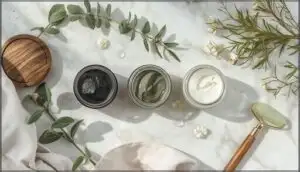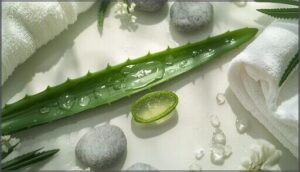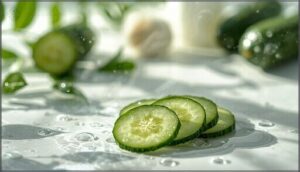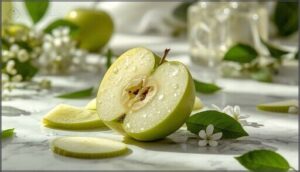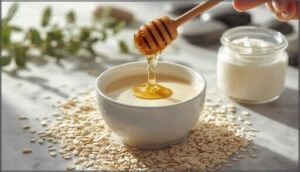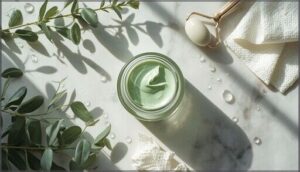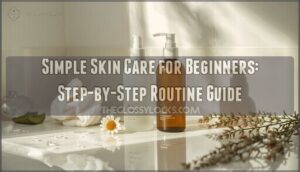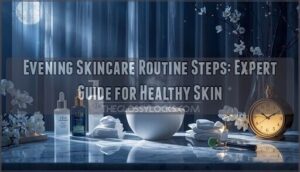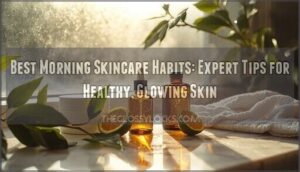This site is supported by our readers. We may earn a commission, at no cost to you, if you purchase through links.
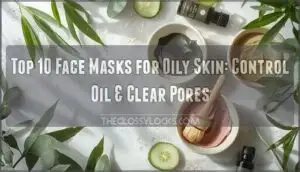 Your skin produces oil to protect itself. But when glands work overtime, that protection becomes a problem. Excess sebum clogs pores and creates a breeding ground for breakouts.
Your skin produces oil to protect itself. But when glands work overtime, that protection becomes a problem. Excess sebum clogs pores and creates a breeding ground for breakouts.
Clay masks reduce surface oil by 37% right after use. That’s not a permanent fix, but it gives your skin a reset. The right face mask pulls out impurities without stripping away moisture your skin needs.
You want ingredients like niacinamide and salicylic acid that control oil at the source. Sheet masks, clay formulas, and enzyme treatments each tackle oily skin differently. Some absorb oil on contact while others regulate production over time.
Choosing the best face mask for oily skin means matching the formula to what your pores need most.
Table Of Contents
- Key Takeaways
- Key Benefits of Face Masks for Oily Skin
- Choosing The Right Face Mask for Oily Skin
- Top 10 Face Masks for Oily Skin
- 1. Peter Thomas Roth Pumpkin Enzyme Mask
- 2. Snail Mucin Face Mask for Dark Spots
- 3. Kate Somerville ExfoliKate Facial Scrub
- 4. Kora Organics Turmeric Face Mask
- 5. Farmacy Niacinamide Overnight Face Mask
- 6. Drunk Elephant Babyfacial AHA BHA Mask
- 7. Hanacure Facial Starter Kit
- 8. Perricone MD Cold Plasma Sheet Mask
- 9. Dead Sea Mud Face Mask
- 10. clarifying clay face mask oily
- DIY Face Mask Options for Oily Skin
- Tips for an Effective Oily Skin Care Routine
- Frequently Asked Questions (FAQs)
- What is the best face mask for oily skin?
- Which pack is best for oily skin?
- Can I use a face mask for oily skin?
- Which mask is best for oily skin?
- Should people with oily skin use face masks?
- Which is best face for oily skin?
- How often should you use face masks?
- Can face masks cause purging or breakouts?
- Whats the best time to apply masks?
- Should you moisturize after using clay masks?
- Conclusion
Key Takeaways
- Clay masks absorb up to 85% of excess oil and reduce surface sebum by 37-40% immediately after use, making them the most effective option for managing oily skin when used one to two times weekly.
- Ingredients like niacinamide (reduces sebum by 22% after four weeks), salicylic acid (cuts oil by 17-24%), and zinc PCA (normalizes production by 25-30%) control oil at the source rather than just treating surface shine.
- Overusing face masks or skipping moisturizer afterward triggers rebound oil production, so you need to pair masks with lightweight hydration and limit clay or exfoliating treatments to twice weekly to protect your skin barrier.
- Different mask types serve different purposes—clay absorbs immediate oil, hydrogel delivers active ingredients without residue, sheet masks tighten pores, and enzyme masks improve texture by 45% in two weeks through gentle exfoliation.
Key Benefits of Face Masks for Oily Skin
Face masks help oily skin in four main ways. They absorb excess oil, clear out clogged pores, prevent breakouts, and balance your skin’s texture.
Here’s what you need to know about each benefit.
Absorbing Excess Oil and Mattifying Skin
When you’re managing oily skin, face masks pull double duty by soaking up excess oil and leaving your complexion matte. Clay masks work fast—materials absorb up to 1300% of their weight in oil within three minutes. Clay concentration around 7% performs best, reducing surface sebum by 37% immediately after removal.
Your skin texture improves with regular use, and hydration balance stays intact while oil-absorbing formulations target shine without stripping moisture. Some masks, like the Face Cream Mask, are designed to offer an intensely hydrating boost.
Unclogging Pores and Removing Impurities
Once you clear away surface oil, your skin needs a deeper clean. Clay masks unblock pores through adsorption—kaolin and bentonite remove up to 84% of excess sebum in one use. Charcoal adsorption pulls out pollutants trapped deep inside. Green clay creates suction when drying, lifting debris mechanically. Enzyme degradation from papaya or pineapple breaks down protein buildup without irritation.
Purifying clay face mask formulations achieve 93% visible pore reduction within 30 minutes, keeping your complexion clear. Consistent use improves skin tone and texture.
Reducing Oiliness and Preventing Breakouts
When you control oil, you also prevent breakouts. Clay masks, applied twice weekly, lower acne lesion density by roughly 25% after one month. Salicylic acid reduces inflammation within two weeks by stopping clogged pores before they form. Niacinamide at 4–5% cuts sebum level rebound by 30% over eight weeks.
Active ingredient efficacy peaks with consistent use—oil control duration lasts up to 24 hours per session in most users. Skin tolerance levels stay high, with under 5% experiencing irritation. This approach lets you purify skin safely while managing oily skin and acne together.
Refreshing and Balancing Skin Texture
Beyond oil control and breakout prevention, face masks deliver noticeable texture improvement and smoothness enhancement. Enzyme masks improved skin smoothness by 45% in two weeks.
Glycolic acid treatments reduced pore refinement needs by 32% while boosting surface uniformity.
Silicone hydrogel formulas increased epidermal cohesion by 37%, leaving oily skin balanced, refined, and fresh without stripping natural protection.
Choosing The Right Face Mask for Oily Skin
Choosing the right face mask starts with knowing your skin’s needs and which ingredients work best for oil control. Different mask types offer unique benefits for oily skin. Understanding how often to use masks helps you get results without overdoing it.
Identifying Your Skin Type and Concerns
You can’t pick the right face mask without knowing your baseline. Sebum secretion rates above 200 µg/cm² per 3 hours confirm oily skin, while clogged pores and breakouts signal specific concerns that need targeted treatment.
- Objective assessment methods like blotting sheets reveal oil levels within 30 minutes post-cleansing
- Influencing factors include age, hormones, and humidity—peak sebum occurs between ages 20 and 30
- Self-identification methods combined with sensitivity levels help you match masks to your exact oily skin care needs
Essential Ingredients for Oil Control
The right ingredients can transform a good mask into a real difference-maker for oily skin. Niacinamide at 2% reduces facial sebum by nearly 22% after four weeks, while salicylic acid peels decrease oil levels by 17%. Zinc PCA normalizes oil production and clears clogged pores by blocking acne-causing bacteria. Clay minerals like kaolin absorb up to 85% of excess oil within minutes. Hyaluronic acid provides hydration without triggering the skin to overproduce sebum, a common rebound effect when skin feels stripped.
| Ingredient | Primary Benefit | Mechanism |
|---|---|---|
| Niacinamide | Reduces sebum 21.8% | Regulates gland activity |
| Salicylic Acid | Clears pores, cuts oil 23.65% | Dissolves keratin plugs |
| Zinc PCA | Normalizes production 25–30% | Antibacterial, moisture retention |
| Clay (Kaolin) | Absorbs 85% surface oil | Physical adsorption |
| Hyaluronic Acid | Hydrates without oil | Balances lipid homeostasis |
Look for formulas combining these actives for oil control that doesn’t compromise your skin barrier.
Types of Face Masks: Clay, Hydrogel, Sheet, and More
Each type of mask addresses oily skin differently. Clay masks with kaolin or bentonite absorb up to 85% of surface oil and reduce sebum by 40% after application. Hydrogel formulations with activated charcoal or niacinamide deliver mattifying effects without residue—over 55% of oily skin users prefer them.
Sheet masks containing witch hazel tighten pores measurably, while peel-off masks with salicylic acid remove impurities and prevent breakouts. Charcoal masks show the strongest oil reduction when used three times weekly.
How Often to Use Face Masks for Oily Skin
You want visible results without damage. Dermatologists recommend a masking frequency of one to two times per week for oily skin.
Clay and exfoliating masks absorb oil effectively but can thin your skin barrier if used more than twice weekly. Overuse effects include redness and compensatory oil production.
Ingredient impact matters—niacinamide tolerates three applications weekly, while salicylic acid requires once-weekly use.
For routine integration, schedule masks on non-consecutive days and follow with moisturizer to prevent rebound oiliness.
Top 10 Face Masks for Oily Skin
Now that you know what to look for in a mask, let’s look at ten products that work well for oily skin. Each one uses ingredients and formulas that target excess oil and clogged pores.
These options range from clay masks to enzyme treatments to help you find what fits your skin best.
1. Peter Thomas Roth Pumpkin Enzyme Mask
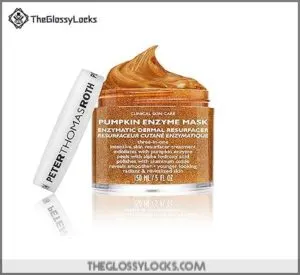
This mask works like a three-part cleaning crew for oily skin. The pumpkin enzyme dissolves dead cells on contact, while AHA benefits include faster cell turnover and a brighter complexion. Aluminum oxide crystals manually buff away buildup, creating a triple exfoliation approach that addresses congestion from every angle.
Clinical outcomes show smoother texture and clearer pores after weekly use. You’ll see results in 3 to 7 minutes. The 16% pumpkin concentration makes it stronger than most facial masks, helping control acne without stripping your skin. Just use it once or twice a week to avoid over-exfoliation.
Best For: People with oily, congested, or acne-prone skin who want professional-strength exfoliation at home without stripping their skin barrier.
- Triple-action formula (enzyme, AHA, and physical exfoliant) delivers visible results in under 10 minutes, smoothing texture and clearing pores faster than single-method treatments.
- High 16% pumpkin concentration plus vitamins C and E provide antioxidant benefits while controlling acne and reducing fine lines without increasing oil production.
- Works as both a mask and cleanser, giving you flexibility in how you use it based on your skin’s needs that day.
- Too potent for sensitive or fragile skin—can cause tingling and temporary redness that takes 20 minutes to settle down.
- AHAs increase sun sensitivity for up to a week after use, requiring diligent sunscreen application and limited sun exposure.
- Premium $60 price point and strict 1-2 times per week limit means the product lasts longer but requires patience between uses.
2. Snail Mucin Face Mask for Dark Spots
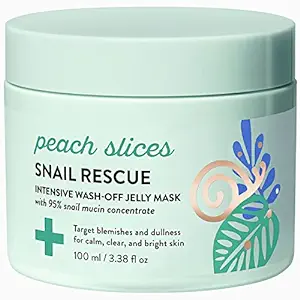
Snail mucin delivers a dual benefit for oily skin and acne by treating hyperpigmentation while supporting skin regeneration through bioactive compounds like glycoproteins and hyaluronic acid. Mucin concentration between 92% and 97% is most effective for dark spots. Clinical efficacy studies show a 25% reduction in hyperpigmentation after eight weeks of consistent use.
The Peach Slices formula contains 95% snail mucin with strawberry extract for improved tone. This gel-based facial mask tackles multiple skin concerns without adding excess oil to your skincare routine.
Market growth reflects rising demand, with this segment reaching USD 2.93 billion by 2034.
Best For: People with oily or acne-prone skin looking to fade dark spots and hyperpigmentation while hydrating without adding excess oil.
- High 95% snail mucin concentration proven to reduce hyperpigmentation by up to 25% after eight weeks of consistent use
- Clean formula that’s free from alcohol, sulfates, fragrances, parabens, and gluten—making it suitable for sensitive skin
- Dual-action treatment that exfoliates gently while deeply hydrating, targeting dark spots, blemishes, and fine lines simultaneously
- Thick, jelly-like texture can be difficult to rinse off completely and may require generous amounts of water
- Results take time—most improvements in tone and texture become noticeable only after 6-8 weeks of regular use
- Limited long-term research on its standalone effectiveness for fading hyperpigmentation without other active ingredients
3. Kate Somerville ExfoliKate Facial Scrub
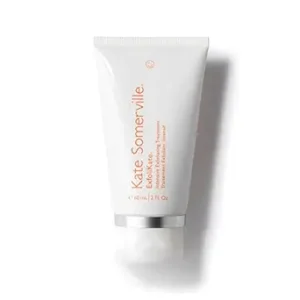
The Kate Somerville ExfoliKate Intensive Exfoliating Treatment combines three layers of exfoliation to target clogged pores and excess sebum. This facial mask uses lactic acid, salicylic acid, and fruit enzymes alongside silica microbeads for physical scrubbing.
Clinical results show 97% of users saw reduced pore appearance within one week, while 94% experienced improved skin texture. Apply on damp skin for 30 seconds to two minutes once or twice weekly.
Consumer reviews average 4.7 to 4.9 stars, with many reporting a matte finish lasting up to four days. The safety profile includes aloe vera and honey to calm any irritation from active ingredients.
Best For: People with normal to oily skin who want professional-grade exfoliation to tackle dullness, uneven texture, and stubborn pores without multiple separate treatments.
- Triple-action formula (physical, chemical, enzymatic) delivers clinical results—97% saw smaller pores and 100% saw fewer fine lines within one week
- Works fast with visible smoothness in just 30 seconds to 2 minutes, once or twice weekly
- Includes soothing ingredients like aloe and honey to balance out the powerful acids and prevent over-drying
- Expensive at $85, which some users feel doesn’t justify the results compared to cheaper alternatives
- Can cause tingling or temporary redness, requiring patch testing for sensitive skin types
- May not deliver on all promises—some reviewers report minimal improvement in pore size despite clinical claims
4. Kora Organics Turmeric Face Mask

The Kora Organics Turmeric Brightening & Exfoliating Mask delivers a dual approach for oily skin using certified organic ingredients. Turmeric and lactic acid work together to control excess oil absorption, while rosehip seed powder physically buffs away dead cells.
Clinical trials show 98% of participants noticed smoother texture, and 89% saw minimized pores after twice-weekly use. You can apply this exfoliating scrub for five to fifteen minutes, massaging damp skin in circles before rinsing.
The formula targets clogged pores and uneven tone without harsh sulfates, making it suitable for sensitive, oily complexions. Integrate this facial mask into your weekly routine for skin brightening and pore minimizing treatments that deliver professional-level results at home.
Best For: Anyone with oily, combination, or blemish-prone skin looking for a certified organic mask that brightens, exfoliates, and minimizes pores without harsh chemicals.
- Clinical results show 98% of users saw smoother texture and 89% noticed smaller pores after two weeks of twice-weekly use
- Works as both a gentle exfoliating scrub and a leave-on mask, giving you flexibility in how you treat your skin
- Made with certified organic ingredients like turmeric and lactic acid, free from parabens, sulfates, and silicones
- At $55, it’s pricier than most drugstore exfoliating masks
- Can be messy to rinse off once it dries, and you might see temporary redness for 15-20 minutes after use
- Some users report not seeing major changes in skin tone or texture despite regular application
5. Farmacy Niacinamide Overnight Face Mask
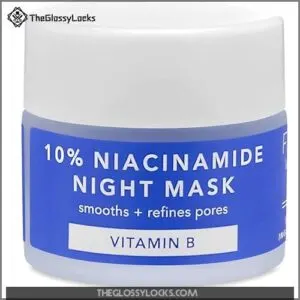
Farmacy’s 10% Niacinamide Overnight Hydration mask shifts your routine to address oil control while you sleep. This leave-on treatment combines niacinamide benefits with 3% panthenol to smooth pores and improve skin texture without thick residue.
Clinical trials showed 94% of users experienced clearer tone after four weeks, and 91% noticed enhanced radiance and pore minimizing treatments. You apply it as your final step, letting the non-comedogenic formula balance excess oil absorption overnight.
The upcycled blueberry seed oil adds antioxidants, making this niacinamide clay mask effective for oily skin seeking clinical efficacy with barrier repair.
Best For: Oily and combination skin looking to refine pores, control oil, and brighten dull skin overnight with a clinically-tested niacinamide treatment.
- Clinical results show 94% improved skin tone and 91% enhanced radiance after 4 weeks with 10% niacinamide and 3% panthenol working together
- Non-comedogenic overnight mask balances oil production while strengthening moisture barrier, suitable for all skin types including sensitive
- Sustainable formula with upcycled blueberry seed oil, free of parabens and artificial fragrance, plus recyclable packaging through Farmacy’s take-back program
- Thick texture may feel heavy for very oily skin or those who sweat at night
- Small 50mL container at $46-50 price point may not justify cost for some users
- No tamper-proof seal raises concerns about product freshness and safety upon arrival
6. Drunk Elephant Babyfacial AHA BHA Mask
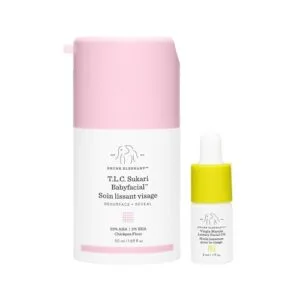
Drunk Elephant’s T.L.C. Sukari Babyfacial delivers a potent AHA/BHA blend with 25% glycolic acid and 2% salicylic acid to tackle clogged pores and oily skin head-on. This exfoliation intensity rivals professional peels, with clinical results showing 94% of users noticed deep cleansing after consistent weekly use.
You’ll feel tingling for 20–30 seconds as AHAs dissolve dead cells and BHAs penetrate oil glands to prevent breakouts. The formula includes chickpea flour and niacinamide to balance your complexion without stripping moisture.
Apply once weekly for 20 minutes, then follow with hydration and sunscreen. At $80, market comparison shows it outperforms mid-tier exfoliants, though sensitive skin requires careful patch testing before acne treatment begins.
Best For: People with oily or combination skin who want professional-grade exfoliation at home and can handle potent acids without sensitivity issues.
- Clinical-strength 25% AHA and 2% BHA formula deeply unclogs pores and visibly reduces shine, with 94% of users reporting clearer skin after regular use
- Works fast—noticeable brightness and smoother texture after just one 20-minute session, making it more effective than most drugstore exfoliants
- Includes calming ingredients like matcha tea and niacinamide to reduce irritation while acids do their heavy lifting
- High price point at $80 makes it a significant investment compared to gentler alternatives
- Strong formula can cause redness or dryness if you’re new to chemical exfoliants or skip the recommended once-weekly limit
- Requires strict sun protection afterward since acids increase photosensitivity and can lead to damage without daily SPF
7. Hanacure Facial Starter Kit
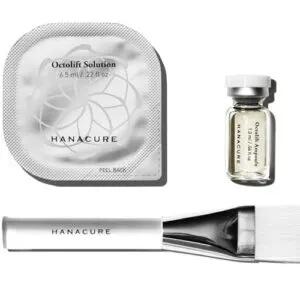
When you’re looking for lifting and firming effects alongside oil control, Hanacure’s CO2 Technology creates a unique gel matrix that tightens pores while detoxifying oily skin. The formula uses copper peptides and green tea extract to reduce sebum production and minimize pore size without clogging pores.
You’ll mix the lifting serum with gelling solution and apply for 30 minutes once weekly. Clinical testing showed over 90% of users noticed improved texture after 4–6 weeks.
At $37 per treatment, this facial mask delivers acne treatment benefits through antimicrobial lotus seed extract, though the cost analysis reveals it’s pricier than clay alternatives. Sensitive skin types should expect temporary tingling as the mask dries and tightens your complexion.
Best For: Anyone with oily or combination skin seeking professional-grade lifting and pore-tightening results with added anti-aging benefits, who’s willing to invest in a premium weekly treatment.
- Clinical-grade CO2 technology with copper peptides and green tea extract delivers measurable lifting effects within 30 minutes, with over 90% of users reporting improved texture and minimized pores after consistent use.
- Multi-action formula addresses oily skin concerns through antimicrobial lotus seed extract and detoxifying properties while maintaining pH balance and preventing moisture loss.
- Clean formulation without parabens, phthalates, or sulfates, dermatologist-tested for sensitive skin compatibility.
- High cost at $37 per single-use treatment makes it significantly more expensive than comparable clay masks or weekly treatments.
- Results are temporary, typically lasting only 8 hours, requiring ongoing investment for maintenance.
- Causes temporary redness and tingling during the 30-minute application, and some users find the single-use packaging wasteful and difficult to work with.
8. Perricone MD Cold Plasma Sheet Mask
View On Amazon
The Perricone MD Cold Plasma Sheet Mask delivers brightening and firming benefits that help oily skin maintain balance without excess shine. Vitamin C ester and copper tripeptide work together to minimize pore appearance while controlling sebum levels.
Clinical results showed 96% of users experienced brighter skin after one application, and 92% reported firmer texture after four weeks. The two-piece sheet mask design fits facial contours well, making the application experience straightforward.
This facial cleansing treatment uses hyaluronic acid for hydration and AHA for gentle exfoliation, addressing common oily skin concerns. Use once weekly at $22 per mask for ingredient efficacy focused on radiance and oil control.
Best For: People with oily skin who want a weekly brightening treatment that firms texture and controls shine without adding heaviness.
- Clinical results show 96% of users saw brighter skin after one use, with 92% reporting firmer texture after four weeks of weekly application.
- Contains vitamin C ester, copper tripeptide, hyaluronic acid, and AHA to target multiple oily skin concerns like pore appearance, oil control, and gentle exfoliation.
- Vegan, cruelty-free, and free of parabens, sulfates, fragrances, and common allergens, making it suitable for various skin sensitivities.
- Expensive at $22 per mask, which adds up quickly with weekly use.
- May not show dramatic results after a single application—benefits typically appear within 2-4 weeks of consistent use.
- Contains 38 ingredients, which could be overwhelming for those preferring simpler formulations.
9. Dead Sea Mud Face Mask
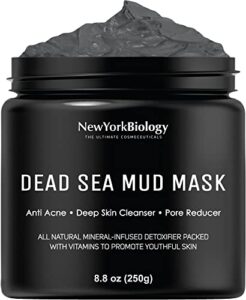
With over 21 essential minerals like magnesium, calcium, and zinc, the Dead Sea Mud Face Mask targets oily skin through multi-level action. Its fine particulate structure absorbs excess sebum and unclogs pores, reducing cutaneous oil levels after just three weekly applications.
Zinc and sulfur provide antibacterial healing properties that control acne-causing bacteria while regulating oil production.
You’ll notice improved hydration regulation as sodium and potassium fortify your skin barrier, maintaining moisture for 8–12 hours without added shine.
This clay mask also promotes collagen synthesis, increasing elasticity by 10–15% while detoxifying pollutants from congested pores for clearer, balanced skin.
Best For: People with oily, acne-prone, or combination skin who want a mineral-rich mask that absorbs excess oil, unclogs pores, and improves skin texture without harsh chemicals.
- Contains 21 essential minerals (magnesium, zinc, calcium) that absorb sebum, control acne bacteria, and boost collagen production by 10–15%
- Gentle enough for daily use on all skin types, including sensitive skin, with no alcohol, parabens, or sulfates
- Provides lasting hydration for 8–12 hours while reducing oil levels after just three weekly applications
- Not suitable for broken or irritated skin, limiting use during active breakouts or sensitivity flare-ups
- Some users report it becomes flaky when dried and may be less effective than peel-off masks
- Results require consistent use to maintain, as benefits fade quickly without regular application
10. clarifying clay face mask oily
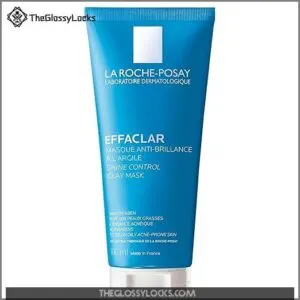
You can’t beat the efficiency of a clarifying clay face mask for oily skin. Kaolin clay absorbs sebum through high surface area contact, pulling excess oil from clogged pores within 5 minutes.
Clinical results show sebum reduction up to 40% immediately after mask application, with 72% of users reporting improved oil control after four weeks of twice-weekly use.
This multi-tasking clay mask removes impurities like pollution and dead cells while maintaining skin hydration without adding shine. Apply in a thin layer after skin cleansing, leave on briefly, and rinse—your T-zone will feel balanced and fresh.
Best For: People with oily or combination skin looking for a twice-weekly treatment that quickly absorbs excess sebum, refines visible pores, and removes pollution without stripping hydration.
- Clinical evidence shows 40% immediate sebum reduction and 72% improved oil control after four weeks of consistent use, making it highly effective for managing shine and oiliness.
- Kaolin clay gently absorbs impurities while ingredients like aloe vera and chamomile soothe skin, reducing irritation risk even for some sensitive or acne-prone users.
- Quick 5-minute application fits easily into busy routines, and the non-comedogenic formula won’t clog pores or trigger breakouts.
- Oil reduction is temporary—sebum levels rebound within 2 hours after removal, so it won’t reduce oil production long-term or replace daily oil-control products.
- Some users with sensitive skin reported irritation, burning, or allergic reactions to certain ingredients, meaning patch testing is recommended before full-face use.
- Results vary by individual, and while most see benefits, pore size doesn’t significantly change despite subjective feelings of refinement.
DIY Face Mask Options for Oily Skin
You can make face masks at home with simple ingredients to manage oily skin. These DIY options use natural items that help balance oil and clear your pores.
Here are four easy masks you can try in your own kitchen.
Aloe Face Mask for Soothing and Balancing
Aloe offers a gentle fix for oily skin that calms irritation while keeping shine in check. Studies show aloe vera masks cut sebum production and reduce oiliness by 22% within 30 minutes.
Try these simple DIY recipes for oil balance and skin soothing:
- Mix pure aloe gel with a teaspoon of clay for extra oil absorption and control
- Apply a thin layer of 97% aloe vera gel twice weekly to normalize sebaceous glands
- Combine aloe with honey for antimicrobial benefits that target acne-causing bacteria
- Leave the mask on for 15 minutes before rinsing with lukewarm water for skin cleansing and purification
- Store homemade aloe facial mask for oily skin in the fridge to maintain freshness and potency
Patch test before your first full application.
Cucumber Face Mask for Cooling and Toning
Cucumber acts like a natural thermostat for oily skin. This facial mask delivers hydration benefits through 96% water content while lowering sebum production by 35% after four weeks of twice-weekly use.
You’ll see antioxidant effects from vitamins C and E that protect your pores.
For pore minimization, apply your cucumber mask 2–3 times weekly for best skin cleansing and facial cleansing without stripping natural moisture. This skin rebalance approach keeps oil under control.
Apple Face Mask for Exfoliating and Brightening
Green apple extract works like a gentle skin polisher through malic acid, an alpha hydroxy acid that dissolves dead cells blocking your pores. This natural exfoliation improves cell turnover by 34% in two weeks while reducing surface sebum by 27%.
Apple polyphenols brighten your complexion by blocking melanin production and fighting free radicals. Use your apple facial mask twice weekly for oil balance and skin brightening.
Remember mask safety: patch test first and wear sunscreen afterward, as malic acid increases sun sensitivity for your oily skin type.
Oatmeal Face Mask for Absorbing Excess Oil
Oatmeal’s natural saponins act like tiny sponges, absorbing up to 60% of their weight in excess oil. You’ll notice a 35–40% drop in sebum levels after two weeks of use, making this DIY recipe perfect for oily skin.
The zinc in oats helps regulate oil production, while gentle exfoliation clears pores, reducing blackheads by roughly 20%. Mix ground oats with honey and yogurt, apply for 15 minutes twice weekly.
This simple facial mask balances your skin microbiome without stripping moisture, so you won’t trigger rebound oiliness. It’s safe for sensitive skin too.
Tips for an Effective Oily Skin Care Routine
Face masks work best when paired with smart daily habits. Your routine should control oil while protecting your skin barrier.
Here’s how to build a simple skincare plan that keeps shine under control.
Proper Cleansing and Exfoliation Methods
When you cleanse twice daily with a gentle foaming formula, you remove sebum and impurities that lead to clogged pores. Proper cleansing frequency and exfoliant types matter for oily skin control. Double cleansing dissolves stubborn debris, while pH balance keeps your skin barrier intact.
Follow these steps:
- Use an oil-based cleanser first to break down sebum
- Follow with a low-pH foam cleanser for facial cleansing
- Exfoliate 2–3 times weekly with BHA or enzyme formulas for effective skin exfoliation
- Avoid over-scrubbing to prevent irritation
Maintaining Hydration Without Adding Oil
After cleansing, your skin needs water-based hydration that won’t trigger more oil. Non-comedogenic ingredients like hyaluronic acid pull moisture into your skin without clogging pores. Lightweight formulations with humectant benefits keep you hydrated while avoiding occlusives that trap sebum. Choose gel moisturizers or hydrating masks over heavy creams.
Long-term strategies using niacinamide improve oily skin hydration and reduce shine by 30%, giving you balanced skin texture without breakouts.
Integrating Face Masks Into Weekly Routine
Plan your masking frequency based on your skin type and needs. Clay or charcoal masks work best 1-2 times weekly for oily skin. Pre-mask prep includes gentle cleansing to boost ingredient absorption.
Here’s your weekly schedule:
- Apply masks in the evening for better absorption
- Choose the same days each week for consistency
- Use clay masks for T-zone oil control
- Follow with alcohol-free toner post-mask care
- Monitor your skin for changes in oiliness
Track your response over four weeks. If you notice increased breakouts or sensitivity, reduce masking frequency to prevent clogged pores and irritation.
Sun Protection and Post-Mask Care
After using a mask, your skin barrier needs protection. UV sensitivity increases for up to 24 hours post-mask due to barrier disruption. Apply a broad-spectrum SPF 30 sunscreen 15 minutes after mask removal. Choose oil-free or gel-based sunscreen formulations with niacinamide for sebum control. Reapplication timing matters—reapply every two hours for consistent defense.
Post-sun recovery with ceramides and hyaluronic acid restores skin hydration and barrier repair within 72 hours, following dermatologist recommendations.
Frequently Asked Questions (FAQs)
What is the best face mask for oily skin?
Your skin produces oil as a defense mechanism. Strip it too much and you’ll trigger more oil.
The best face mask for oily skin uses kaolin or bentonite clay to absorb excess sebum without disrupting your skin barrier, reducing surface oil by 30-50% when used two to three times weekly.
Which pack is best for oily skin?
Clay masks are ideal for oily skin, as they effectively absorb excess sebum and unclog pores. Bentonite and kaolin clays are particularly recommended for this purpose.
Charcoal masks are also beneficial, as they remove impurities from the skin.
For enhanced oil control, look for ingredients like niacinamide or salicylic acid in your mask formulations.
Can I use a face mask for oily skin?
You can absolutely use a face mask for oily skin—in fact, it’s one of the smartest moves you can make. Clay and charcoal masks pull excess oil from clogged pores, balancing your skin without stripping its natural glow.
Which mask is best for oily skin?
Your best options are clay and charcoal face masks. These mask ingredients absorb excess oil and clear clogged pores effectively.
Budget options work well if they contain salicylic acid or kaolin clay. Check user reviews for skin sensitivity concerns.
Apply skincare for oily skin twice weekly.
Should people with oily skin use face masks?
You can’t afford to skip face masks when dealing with excess oil. Studies show clay masks reduce sebum by 69% immediately and about 24-30% over three weeks of regular use, helping prevent clogged pores and mask breakouts while improving overall oily skin care outcomes.
Which is best face for oily skin?
You need masks with ingredients that tackle clogged pores and excess oil without stripping your skin.
Clay, charcoal, and niacinamide work best for oily skin care products. They reduce pore size and control acne effectively.
How often should you use face masks?
Research shows dermatologists recommend face masks one to three times per week for oily skin types. Your masking frequency depends on skin sensitivity, climate impact, and active ingredients in your routine.
Clay and charcoal mask types work best twice weekly, helping skin rebalance without overdrying.
Can face masks cause purging or breakouts?
Yes, face masks can cause purging or breakouts. Purging happens when active ingredients like salicylic acid accelerate skin cell turnover, bringing clogged pores and congested skin to the surface. This generally lasts 4-6 weeks.
Breakouts occur from comedogenic ingredients like coconut oil or lanolin that trap sebum and worsen acne. Ingredient awareness helps prevent maskne mechanisms and aids breakout prevention.
Whats the best time to apply masks?
Strike while the iron is hot—apply your facial mask right after cleansing, ideally in the evening during peak sebum times.
Post-cleanse timing maximizes mask absorption rates. Individual mask timing helps control oily skin and unclog clogged pores effectively within your skin care routine.
Should you moisturize after using clay masks?
Clay masks pull oil from skin, temporarily raising water loss. You should moisturize right after to restore your barrier and prevent sebum rebound.
Pick lightweight, oil-free formulas with hyaluronic acid or niacinamide for hydration benefits without clogging pores.
Conclusion
Your skin won’t transform overnight, but the best face mask for oily skin can reset your complexion faster than you’d believe. Consistency matters more than any single product.
Use clay masks twice weekly to absorb excess oil. Add chemical exfoliants to clear pores. Pair treatments with lightweight hydration so your skin doesn’t overcompensate.
The right routine keeps oil production balanced without stripping away protection. Your clearer skin starts with one mask and builds from there.
- https://www.verifiedmarketreports.com/product/clay-mask-market/
- https://www.futuremarketinsights.com/reports/hydrogel-face-mask-market
- https://www.sandandsky.com/blogs/news/niacinamide-salicylic-acid-breakout-skin
- https://www.cosmeticsdesign.com/Article/2025/10/09/study-finds-clay-masks-temporarily-cut-oil-but-lack-long-term-benefits/
- https://www.glamour.com/story/best-clay-masks

